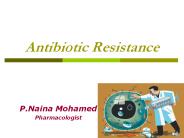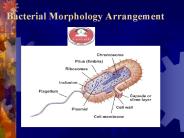Bacterial Resistance PowerPoint PPT Presentations
All Time
Recommended
Antimicrobial compounds are substances that kill or inhibit the growth of microorganisms, including bacteria. However, some bacteria have developed resistance to these compounds, making them less effective in controlling infections. Visit the official website of IPNR Endura for Chemicals, Minerals and raw materials.
| PowerPoint PPT presentation | free to download
Bacterial resistance to MAC
| PowerPoint PPT presentation | free to view
how prepare bacterial smear, and types of staining
| PowerPoint PPT presentation | free to view
Integrated Genomics to Enhance Host Resistance to Bacterial Colonization in Poultry
| PowerPoint PPT presentation | free to view
Bacterial Source Tracking by Multiple Antibiotic Resistance Analysis of Escherichia coli Bacterial Source Tracking (BST) Determination of the sources of fecal ...
| PowerPoint PPT presentation | free to view
Supplementary Figure 2 Bacterial disease resistance is determined by ... A null mutation of FLS2 leads to enhanced disease susceptibility. Wild-type Col-0 and ...
| PowerPoint PPT presentation | free to download
Presentation BIRO TECHNOLOGIES INC. EPOXY-SILOXANE COATING TECHNOLOGY This document describes an ambiant-cure epoxy-siloxane coating, exhibiting excellent corrosion ...
| PowerPoint PPT presentation | free to download
Phage Biotech Ltd. develops and produces bacteriophages anti-bacterials which ... barriers Routine use of anti-microbial agents in hospitals creates ...
| PowerPoint PPT presentation | free to view
Introduction to antimicrobial resistance Since the development of Penicillin in 1920, ... The testing included susceptibility analysis of penicillin G, tetracycline, ...
| PowerPoint PPT presentation | free to download
Antibiotic Resistance, its various causes, bacterial mechanisms and possible solutions are discussed in this presentation. All the mechanisms behind each action are explained in schematic representations for easy understandings.
| PowerPoint PPT presentation | free to download
(PRICE LOWERED)Microbiology, Bacterial Pathogens
| PowerPoint PPT presentation | free to download
Antibiotics and Antibiotic Resistance Antibiotics Antibiotics are powerful medicines that fight bacterial infection Literal translation anti against biotic ...
| PowerPoint PPT presentation | free to view
The global antimicrobial resistance market size was valued at $4.6 billion in 2022, and is projected to reach $9.5 billion by 2032, growing at a CAGR of 7.6% from 2023 to 2032.
| PowerPoint PPT presentation | free to download
The global antimicrobial resistance market size was valued at $4.6 billion in 2022, and is projected to reach $9.5 billion by 2032, growing at a CAGR of 7.6% from 2023 to 2032.
| PowerPoint PPT presentation | free to download
Growing up of antibiotics resistance
| PowerPoint PPT presentation | free to view
Antibiotic Resistance The Challenge in a Changing World The Scene: Maddy is sick. Poor little girl seems to have some sort of upper respiratory illness.
| PowerPoint PPT presentation | free to view
Type of Skin Infection-1 Skin infection increased by presence of minor skin ... Staphylococci are becoming increasingly resistant to many commonly used ...
| PowerPoint PPT presentation | free to download
3 domain system
| PowerPoint PPT presentation | free to download
Chapter 5 Bacterial genetics
| PowerPoint PPT presentation | free to download
Antibiotic Resistance Why Evolution is Important Now
| PowerPoint PPT presentation | free to download
Bacterial Diseases Food Intoxication Clostridium perfringens Gastroenteritis: one of the more common forms of food poisoning in the United States improper handling of ...
| PowerPoint PPT presentation | free to view
Bacterial Infection DAP
| PowerPoint PPT presentation | free to download
Bacterial Genomes Remember no nucleus!! Bacterial chromosome - Large ds circular DNA molecule = haploid - E. coli has about 4,300 genes (~4.2 Mb)
| PowerPoint PPT presentation | free to view
Pathogenicity & Infection. Pathogenicity is the ability of a microbe to gain entry to the host s tissue and bring about a physiological or anatomical change ...
| PowerPoint PPT presentation | free to view
ANTIMICROBIAL RESISTANCE Prof. Khalifa Sifaw Ghenghesh Each class of antimicrobial agent has a unique mode of action. Some antibiotics differ in their action on Gram ...
| PowerPoint PPT presentation | free to view
Microbiological control of medicines in pharmaceutical manufacturing and pharmaceutical companies. Fundamentals of biotechnology and genetic engineering.
| PowerPoint PPT presentation | free to view
Title: Ligation and Transformation Last modified by: 000762265 Created Date: 6/13/2005 1:05:43 PM Document presentation format: On-screen Show (4:3)
| PowerPoint PPT presentation | free to download
Title: Bacterial Genetics Author: g-max Last modified by: uoj Created Date: 10/16/2004 12:40:04 PM Document presentation format: On-screen Show Other titles
| PowerPoint PPT presentation | free to download
Mrs. Stewart Central Magnet School Courtesy of: www.bios.niu.edu/johns/annot/Bacterial%20Structures.ppt
| PowerPoint PPT presentation | free to view
Bacterial Reproduction * * Introduction Bacteria can reproduce in one of two ways: Asexually Sexually * * Asexual Reproduction Binary Fission: one parent involved ...
| PowerPoint PPT presentation | free to download
100x more DNA than the average virus. 1000x less DNA than ... Avirulent. a-hemolysis. of RBCs. Blood Agar Plate. No capsule! 12. 13. The Transforming Principle ...
| PowerPoint PPT presentation | free to view
The global antibiotic resistance market is anticipated to reach US$ 15.32 billion by 2028; growing at a CAGR of 6.3% during the forecast period, 2021 – 2028. Antibiotic resistance is a condition that occurs when the pathogens like bacteria & fungi develop the ability to minimize & kill the effects of the drugs designed to kill them i.e., the bacteria & fungi become immune to the drugs. This simply means that the drug has no effect on the bacteria & fungi and they continue to grow influentially. This condition is mostly developed by the excessive and uncontrolled use of antibiotics.
| PowerPoint PPT presentation | free to download
Bacterial Genetics Review Genome ... Transduction Bacterial DNA is transferred via a virus -Bacteriophage Virulent phages lytic cycle Generalized transduction Any gene ...
| PowerPoint PPT presentation | free to view
Bacterial Genetics By Dr. Emad AbdElhameed Morad Lecturer of Medical Microbiology and Immunology Plasmids Extra-chromosomal circular double stranded DNA molecules.
| PowerPoint PPT presentation | free to view
A section of DNA that has enough information to make one protein is ... BST. Genetically modified foods. Bioremediation. How? Use enzymes to cut plasmid DNA ...
| PowerPoint PPT presentation | free to view
Medical Microbiology Bacterial Toxins BIOL 533 Lecture 9 Bacterial Toxins: General Aspects Definition Soluble substances that alter normal metabolism of host cells ...
| PowerPoint PPT presentation | free to view
Bacterial Genetics Xiao-Kui GUO PhD ... Transduction is defined as the transfer of genetic information between cells through the mediation of a virus ...
| PowerPoint PPT presentation | free to view
Bacterial Anatomy
| PowerPoint PPT presentation | free to view
Variation in bacteria mainly caused by mutation ... Anatomy of the lac operon ... Effect of lactose on the lac operon. Energy preference of E.coli ...
| PowerPoint PPT presentation | free to view
Gonorrhea. Females. vaginitis, urethritis, salpingitis (PID) mixed anaerobic abdominal infection ... Gonorrhea in Newborns. Infected as they pass through birth ...
| PowerPoint PPT presentation | free to view
Preparation of competent cells and bacterial transformation ... When plated on media containing ampicillin, transformants harboring plasmids ...
| PowerPoint PPT presentation | free to view
... that alter normal metabolism of host cells with deleterious effects on the host ... Known for bacteria, but possible that they play a role in diseases caused by ...
| PowerPoint PPT presentation | free to view
Bacterial Morphology Arrangement Robert Hooke (1635-1703) English Scientist First to use the microscope to observe cells Coined the term cell Anton van ...
| PowerPoint PPT presentation | free to download
Bacteria continue to out-perform clinician by developing increasing levels of resistance. Protecting the efficacy of existing antibiotic armamentarium is essential. ...
| PowerPoint PPT presentation | free to view
NNT (otitis media) = 71 NNT (quinsy) = 50. 0.18 0.41. 0.27. Rheumatic fever. 0.07 0.35 ... Quinsy. 0.11 0.43. 0.22. Otitis media. 95% CI. Odds ratio ...
| PowerPoint PPT presentation | free to view
E. Coli, Salmonella, Shigella, Campylobacter, Vibrio, Yersinia, Clostridium difficle ... Rare in Salmonella, Yersinia, ETEC, EAEC. Treatment of Diarrhea ...
| PowerPoint PPT presentation | free to view
Stress resistance. A&S300-002 Jim Lund. Studied experimentally in model organisms, ... Genes and conditions that activate ... to stress (thermic and others) ...
| PowerPoint PPT presentation | free to view
... Scours. Several types- Colibacillosis (e. coli), Enterotoxcemia (clostridium perfringens) ... With all types of scours, both bacterial and viral, the ...
| PowerPoint PPT presentation | free to download
Antimicrobial Resistance Steven M Gordon Dept of Infectious Disease Cleveland Clinic Cleveland Clinic Journal of Medicine Volume 65, Number 5, May 1998
| PowerPoint PPT presentation | free to view
Bacteria that stain violet when exposed to gram stain What is Gram positive bacteria? ... Salt-loving Archaebacteria What are halophiles?
| PowerPoint PPT presentation | free to view
This presentation discusses the overview, history, transmission,diagnosis,treatment ,prevention and research involved in treating Methicillin Resistant Staphylococcus Areus (MRSA)
| PowerPoint PPT presentation | free to view
Strep Pneumonia: 20-40% resistant to penicillins/cephalosporins. Antibiotic Resistance in O.M. ... the drug-resistant Streptococcus pneumonia working group. ...
| PowerPoint PPT presentation | free to view
lysis: splitting open of the bacteria (ie. to release phage) ... 1 bacteria lyses, releasing 100's of phage, they infect nearby bacteria, etc ...
| PowerPoint PPT presentation | free to view
Bacterial Growth and Nutrition Bacterial nutrition and culture media Chemical and physical factors affecting growth The nature of bacterial growth
| PowerPoint PPT presentation | free to download
may be a primary skin infection or may occur as a secondary ... Guillain-Barre syndrome. MG. Eaton-Lambert syndrome. poliomyelitis. Toxins. Anticholinergics ...
| PowerPoint PPT presentation | free to view
Bacterial Growth and Nutrition Bacterial nutrition and culture media Chemical and physical factors affecting growth The nature of bacterial growth
| PowerPoint PPT presentation | free to download
























































